Application of Sensory Methods to Evaluate the Effectiveness of Solutions to Reduce the Exposure to Odour Nuisance and Ammonia Emissions from the Compost Heaps
Abstract
1. Introduction
2. Materials and Methods
2.1. Description of the Research Object
2.2. Examined Variants
2.3. Characteristics of the Used Preparations
2.4. Gas Sampling
2.5. Odour Measurement
2.6. Measurement of Ammonia, Temperature, and Humidity
2.7. Statistical Methods
- Conducting one-way ANOVA to determine statistically significant differences between groups.
- If the ANOVA test is statistically significant, a DSCF analysis for pairwise comparisons should be conducted.
- Calculating the differences between group means and the mean of the control (or reference) group.
- Establishing confidence intervals for these differences.
- Checking if the confidence intervals do not contain zero. If the confidence intervals do not include zero, it indicates that the differences between groups are statistically significant.
2.8. Methodology
- From the height of 1.5 m above the plateau of the pile;
- Using static chamber from the surface of the pile;
- From a depth of 10 cm.
3. Results and Discussion
3.1. Comparison of Research Variants
3.2. Correlations between Variables
3.3. Comparison of Results by Week of a Study
3.3.1. Preparation A (Variant T1)
3.3.2. Preparation 2 (Variant T2)
3.3.3. Without Addition of Preparation (Variant T3)
3.3.4. Preparation A (Variant T4)
3.3.5. Preparation 2 (Variant T5)
3.3.6. Without Addition of Preparation (Variant T6)
3.3.7. Preparation A (Variant T7)
3.3.8. Preparation 2 (Variant T8)
3.3.9. Without Addition of Preparation (Variant T9)
3.3.10. Summary of Comparison of Results by Week of a Study
4. Conclusions
Author Contributions
Funding
Institutional Review Board Statement
Informed Consent Statement
Data Availability Statement
Conflicts of Interest
References
- Hoang, H.G.; Thuy, B.T.P.; Lin, C.; Vo, D.-V.N.; Tran, H.T.; Bahari, M.B.; Le, V.G.; Vu, C.T. The Nitrogen Cycle and Mitigation Strategies for Nitrogen Loss during Organic Waste Composting: A Review. Chemosphere 2022, 300, 134514. [Google Scholar] [CrossRef]
- Heroux, M.; Page, T.; Gelinas, C.; Guy, C. Evaluating Odour Impacts from a Landfilling and Composting Site: Involving Citizens in the Monitoring. Water Sci. Technol. 2004, 50, 131–137. [Google Scholar] [CrossRef]
- Pagans, E.; Barrena, R.; Font, X.; Sánchez, A. Ammonia Emissions from the Composting of Different Organic Wastes. Dependency on Process Temperature. Chemosphere 2006, 62, 1534–1542. [Google Scholar] [CrossRef]
- Sironi, S.; Capelli, L.; Centola, P.; Del Rosso, R.; Il Grande, M. Continuous Monitoring of Odours from a Composting Plant Using Electronic Noses. Waste Manag. 2007, 27, 389–397. [Google Scholar] [CrossRef]
- Gallego, E.; Roca, F.; Perales, J.-F.; Sánchez, G.; Esplugas, P. Characterization and Determination of the Odorous Charge in the Indoor Air of a Waste Treatment Facility through the Evaluation of Volatile Organic Compounds (VOCs) Using TD-GC/MS. Waste Manag. 2012, 32, 2469–2481. [Google Scholar] [CrossRef]
- Nicell, J.A. Assessment and Regulation of Odour Impacts. Atmos. Environ. 2009, 43, 196–206. [Google Scholar] [CrossRef]
- Scaglia, B.; Orzi, V.; Artola, A.; Font, X.; Davoli, E.; Sanchez, A.; Adani, F. Odours and Volatile Organic Compounds Emitted from Municipal Solid Waste at Different Stage of Decomposition and Relationship with Biological Stability. Bioresour. Technol. 2011, 102, 4638–4645. [Google Scholar] [CrossRef]
- Sironi, S.; Capelli, L.; Dentoni, L.; Del Rosso, R. Odour Regulation and Policies. In Odour Impact Assessment Handbook; John Wiley & Sons, Ltd.: Hoboken, NJ, USA, 2012; pp. 175–186. ISBN 978-1-118-48126-4. [Google Scholar]
- Sironi, S.; Capelli, L.; Centola, P.; Del Rosso, R. Odour Emissions from MSW Composting Process Steps. Int. J. Environ. Technol. Manag. 2007, 7, 304–316. [Google Scholar] [CrossRef]
- Galwa-Widera, M.I. Reduction of Odors from Composting Processes Using an Ecological Method. J. Ecol. Eng. 2021, 22, 88–95. [Google Scholar] [CrossRef]
- Chou, C.-H.; Büyüksönmez, F. Biogenic Emissions from Green Waste and Comparison to the Emissions Resulting from Composting (Part 1: Ammonia). Compos. Sci. Util. 2006, 14, 16–22. [Google Scholar] [CrossRef]
- Isidorov, V.; Jdanova, M. Volatile Organic Compounds from Leaves Litter. Chemosphere 2002, 48, 975–979. [Google Scholar] [CrossRef]
- Pierucci, P.; Porazzi, E.; Martinez, M.P.; Adani, F.; Carati, C.; Rubino, F.M.; Colombi, A.; Calcaterra, E.; Benfenati, E. Volatile Organic Compounds Produced during the Aerobic Biological Processing of Municipal Solid Waste in a Pilot Plant. Chemosphere 2005, 59, 423–430. [Google Scholar] [CrossRef]
- Eitzer, B.D. Emissions of Volatile Organic Chemicals from Municipal Solid Waste Composting Facilities. Environ. Sci Technol. 1995, 29, 896–902. [Google Scholar] [CrossRef]
- Smet, E.; Van Langenhove, H.; De Bo, I. The Emission of Volatile Compounds during the Aerobic and the Combined Anaerobic/Aerobic Composting of Biowaste. Atmos. Environ. 1999, 33, 1295–1303. [Google Scholar] [CrossRef]
- Clemens, J.; Cuhls, C. Greenhouse Gas Emissions from Mechanical and Biological Waste Treatment of Municipal Waste. Environ. Technol. 2003, 24, 745–754. [Google Scholar] [CrossRef]
- Defoer, N.; De Bo, I.; Van Langenhove, H.; Dewulf, J.; Van Elst, T. Gas Chromatography-Mass Spectrometry as a Tool for Estimating Odour Concentrations of Biofilter Effluents at Aerobic Composting and Rendering Plants. J. Chromatogr. A 2002, 970, 259–273. [Google Scholar] [CrossRef]
- Defoer, N.; Van Langenhove, H. Odour Emissions During Yard Waste Composting: Effect of Turning Frequency. In Microbiology of Composting; Insam, H., Riddech, N., Klammer, S., Eds.; Springer: Berlin/Heidelberg, Germany, 2002; pp. 561–569. [Google Scholar]
- Cadena, E.; Colón, J.; Sánchez, A.; Font, X.; Artola, A. A Methodology to Determine Gaseous Emissions in a Composting Plant. Waste Manag. 2009, 29, 2799–2807. [Google Scholar] [CrossRef]
- Alvarado, A.; Predicala, B.; Asis, D. Mixing Nanoparticles with Swine Manure to Reduce Hydrogen Sulfide and Ammonia Emissions. Int. J. Environ. Sci. Technol. 2014, 12, 893–904. [Google Scholar] [CrossRef][Green Version]
- Ubeda, Y.; Ferrer, M.; Sanchis, E.; Calvet, S.; Nicolas, J.; López, P.A. Evaluation of Odour Impact from a Landfill Area and a Waste Treatment Facility through the Application of Two Approaches of a Gaussian Dispersion Model. In Proceedings of the 5th International Congress on Environmental Modelling and Software, Ottawa, ON, Canada, 5–8 July 2010. [Google Scholar]
- Sironi, S.; Capelli, L.; Céntola, P.; Rosso, R.D.; Grande, M.I. Odour Emission Factors for the Prediction of Odour Emissions from Plants for the Mechanical and Biological Treatment of MSW. Atmos. Environ. 2006, 39, 7632–7643. [Google Scholar] [CrossRef]
- Capelli, L.; Sironi, S. Renato Del Rosso Odour Emission Factors: Fundamental Tools for Air Quality Management. Chem. Eng. Trans. 2014, 40, 193–198. [Google Scholar] [CrossRef]
- Sanchez-Monedero, M.A.; Stentiford, E.I.; Mondini, C. Biofiltration at Composting Facilities: Effectiveness for Bioaerosol Control. Environ. Sci. Technol. 2003, 37, 4299–4303. [Google Scholar] [CrossRef]
- Domingo, J.L.; Nadal, M. Domestic Waste Composting Facilities: A Review of Human Health Risks. Environ. Int. 2009, 35, 382–389. [Google Scholar] [CrossRef]
- Dorado, A.D.; Husni, S.; Pascual, G.; Puigdellivol, C.; Gabriel, D. Inventory and Treatment of Compost Maturation Emissions in a Municipal Solid Waste Treatment Facility. Waste Manag. 2014, 34, 344–351. [Google Scholar] [CrossRef]
- Gabriel, D.; Maestre, J.P.; Martín, L.; Gamisans, X.; Lafuente, J. Characterisation and Performance of Coconut Fibre as Packing Material in the Removal of Ammonia in Gas-Phase Biofilters. Biosyst. Eng. 2007, 97, 481–490. [Google Scholar] [CrossRef]
- Witherspoon, J.R.; Adams, G.; Cain, W.; Cometto-Muniz, E.; Forbes, B.; Hentz, L.; Novack, J.T.; Higgins, M.; Murthy, S.; McEwen, D.; et al. Water Environment Research Foundation (WERF) Anaerobic Digestion and Related Processes, Odour and Health Effects Study. Water Sci. Technol. 2004, 50, 9–16. [Google Scholar] [CrossRef]
- Luginaah, I.N.; Taylor, S.M.; Elliott, S.J.; Eyles, J.D. Community Reappraisal of the Perceived Health Effects of a Petroleum Refinery. Soc. Sci. Med. 2002, 55, 47–61. [Google Scholar] [CrossRef]
- Sucker, K.; Both, R.; Winneke, G. Review of Adverse Health Effects of Odours in Field Studies. Water Sci. Technol. 2009, 59, 1281–1289. [Google Scholar] [CrossRef]
- Herr, C.; zur Nieden, A.; Bodeker, R.; Gieler, U.; Eikmann, T. Ranking and Frequency of Somatic Symptoms in Residents near Composting Sites with Odor Annoyance. Int. J. Hyg. Environ. Health 2003, 206, 61–64. [Google Scholar] [CrossRef]
- Herr, C.E.W.; Zur Nieden, A.; Kopka, I.; Rethage, T.; Gieler, U.; Eikmann, T.F.; Stilianakis, N.I. Assessment of Somatic Complaints in Environmental Health. Int. J. Hyg. Environ. Health 2009, 212, 27–36. [Google Scholar] [CrossRef]
- Tolvanen, O.; Nykänen, J.; Nivukoski, U.; Himanen, M.; Veijanen, A.; Hänninen, K. Occupational Hygiene in a Finnish Drum Composting Plant. Waste Manag. 2005, 25, 427–433. [Google Scholar] [CrossRef]
- Komilis, D.P.; Ham, R.K.; Park, J.K. Emission of Volatile Organic Compounds during Composting of Municipal Solid Wastes. Water Res. 2004, 38, 1707–1714. [Google Scholar] [CrossRef]
- Kret, J.; Dalidowitz Dame, L.; Tutlam, N.; DeClue, R.W.; Schmidt, S.; Donaldson, K.; Lewis, R.; Rigdon, S.E.; Davis, S.; Zelicoff, A.; et al. A Respiratory Health Survey of a Subsurface Smoldering Landfill. Environ. Res. 2018, 166, 427–436. [Google Scholar] [CrossRef]
- Heaney, C.D.; Wing, S.; Campbell, R.L.; Caldwell, D.; Hopkins, B.; Richardson, D.; Yeatts, K. Relation between Malodor, Ambient Hydrogen Sulfide, and Health in a Community Bordering a Landfill. Environ. Res. 2011, 111, 847–852. [Google Scholar] [CrossRef]
- Lipscomb, J.A.; Goldman, L.R.; Satin, K.P.; Smith, D.F.; Vance, W.A.; Neutra, R.R. A Follow-up Study of the Community near the McColl Waste Disposal Site. Environ. Health Perspect. 1991, 94, 15–24. [Google Scholar] [CrossRef]
- Aatamila, M.; Verkasalo, P.K.; Korhonen, M.J.; Suominen, A.L.; Hirvonen, M.-R.; Viluksela, M.K.; Nevalainen, A. Odour Annoyance and Physical Symptoms among Residents Living near Waste Treatment Centres. Environ. Res. 2011, 111, 164–170. [Google Scholar] [CrossRef]
- Shusterman, D.; Lipscomb, J.; Neutra, R.; Satin, K. Symptom Prevalence and Odor-Worry Interaction near Hazardous Waste Sites. Environ. Health Perspect. 1991, 94, 25–30. [Google Scholar] [CrossRef]
- Baldacci, S.; Maio, S.; Martini, F.; Silvi, P.; Giuseppe, S.; Cerrai, S.; Angino, A.; Fresta, M.; Viegi, G. Odor Annoyance Perception and Health Effects in an Italian General Population Sample. Eur. Respir. J. 2015, 46, PA1115. [Google Scholar] [CrossRef]
- Blanes-Vidal, V. Air Pollution from Biodegradable Wastes and Non-Specific Health Symptoms among Residents: Direct or Annoyance-Mediated Associations? Chemosphere 2015, 120, 371–377. [Google Scholar] [CrossRef]
- Manu, M.K.; Kumar, R.; Garg, A. Performance Assessment of Improved Composting System for Food Waste with Varying Aeration and Use of Microbial Inoculum. Bioresour. Technol. 2017, 234, 167–177. [Google Scholar] [CrossRef]
- Zhao, X.; Lu, H.; Xin, H.; Shi, Q.; Li, D.; Liu, L.; Sun, Z. Improve Avermectin Fermentation Residue Decomposition Efficiency, Bacterial Community and Mature Compost Quality by Inoculating Mature Compost. Waste Biomass Valor 2024, 15, 3785–3802. [Google Scholar] [CrossRef]
- Szyłak-Szydłowski, M. Validation of Odor Concentration from Mechanical-Biological Treatment Piles Using Static Chamber and Wind Tunnel with Different Wind Speed Values. J. Air Waste Manag. Assoc. 2017, 67, 1046–1054. [Google Scholar] [CrossRef] [PubMed]
- Kulig, A.; Szyłak-Szydłowski, M. Assessment of the Effects of Wastewater Treatment Plant Modernization by Means of the Field Olfactometry Method. Water 2019, 11, 2367. [Google Scholar] [CrossRef]
- Szyłak-Szydłowski, M. Odour Samples Degradation During Detention in Tedlar® Bags. Water Air Soil. Pollut. 2015, 226, 227. [Google Scholar] [CrossRef] [PubMed][Green Version]
- ISO 13301:2018-Sensory Analysis—Methodology—General Guidance for Measuring Odour, Flavour and Taste Detection Thresholds by a Three-Alternative Forced-Choice (3-AFC) Procedure. Available online: https://standards.iteh.ai/catalog/standards/iso/5310d849-514e-4783-8882-1943f2dcdfad/iso-13301-2018 (accessed on 25 June 2024).
- Szyłak-Szydłowski, M.; Kulig, A. Deodorisation of Ventilated Air from a Fat-Processing Plant Using Different Types of Biofilter Fillings and Membranes. Sustainability 2024, 16, 1939. [Google Scholar] [CrossRef]
- Biasioli, F.; Gasperi, F.; Odorizzi, G.; Aprea, E.; Mott, D.; Marini, F.; Autiero, G.; Rotondo, G.; Mark, T. PTR-MS Monitoring of Odour Emissions from Composting Plants. Int. J. Mass Spectrom. 2004, 239, 103–109. [Google Scholar] [CrossRef]
- Sekeran, V.; Balaji, C.; Bhagavathipushpa, T. Technical Note: Evaluation of Effective Microorganisms (EM) In Solid Waste Management. Electron. Green J. 2005, 1, 1–5. [Google Scholar] [CrossRef]
- Fan, Y.; Lee, C.T.; Leow, C.; Chua, L.S.; Samidi, M. Physico-Chemical and Biological Changes during Co-Composting of Model Kitchen Waste, Rice Bran and Dried Leaves with Different Microbial Inoculants. Malays. J. Anal. Sci. 2016, 20, 1447–1457. [Google Scholar] [CrossRef]
- Khalil, A.I.; Hassouna, M.S.E.-D.; Shaheen, M.M. Monitoring of Physical, Chemical, Microbial and Enzymatic Parameters during Composting of Municipal Solid Wastes: A Comparative Study. J. Pure Appl. Microbiol. 2014, 8, 211–224. [Google Scholar]
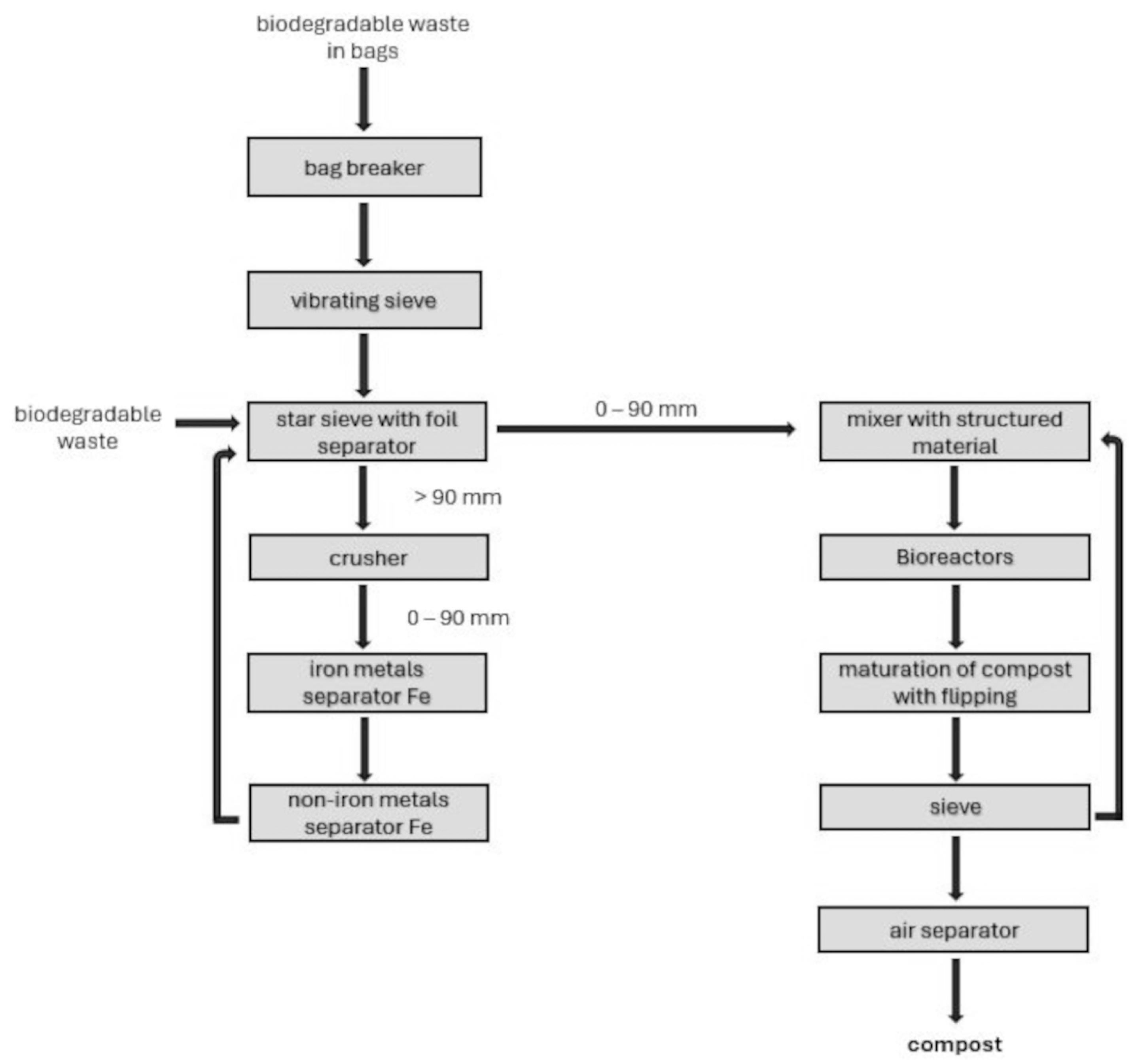
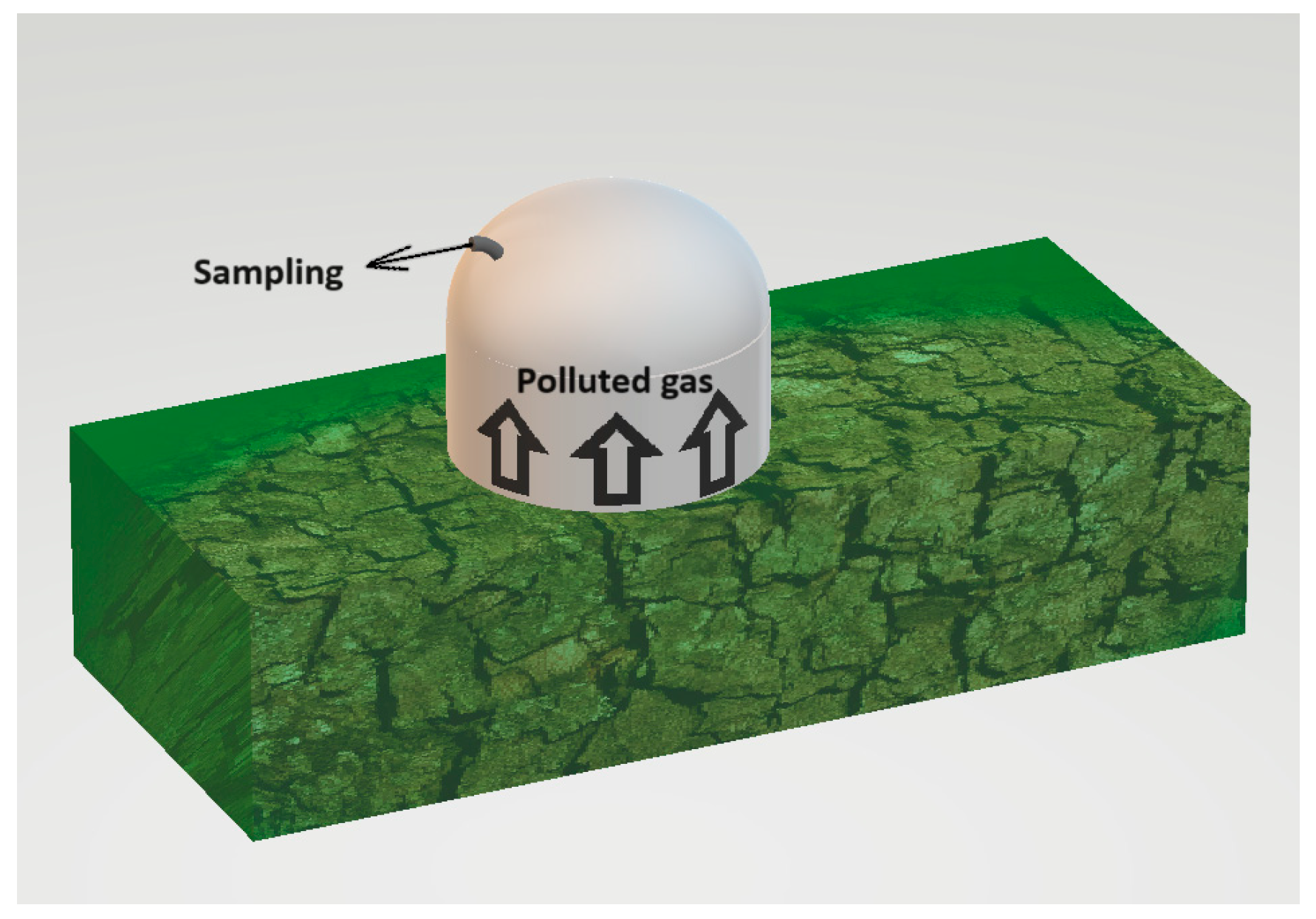
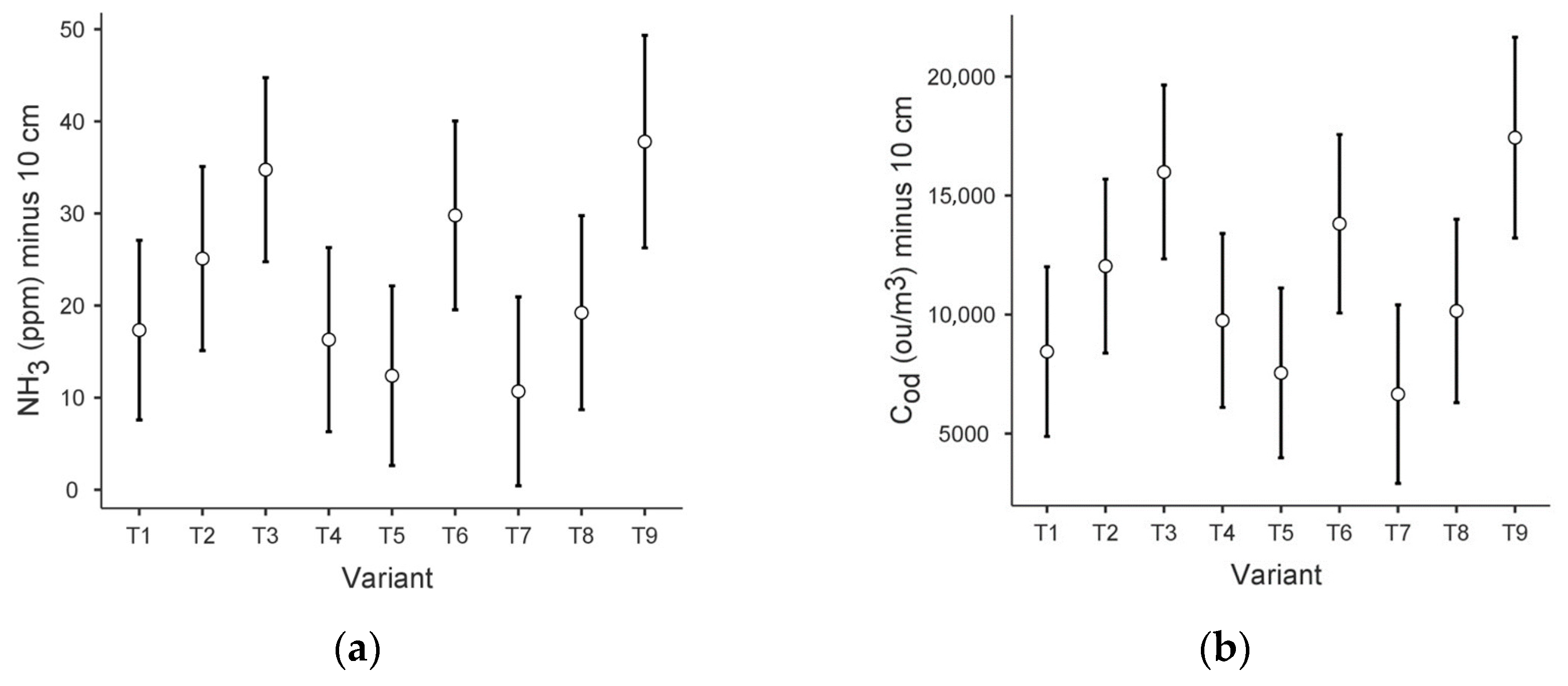
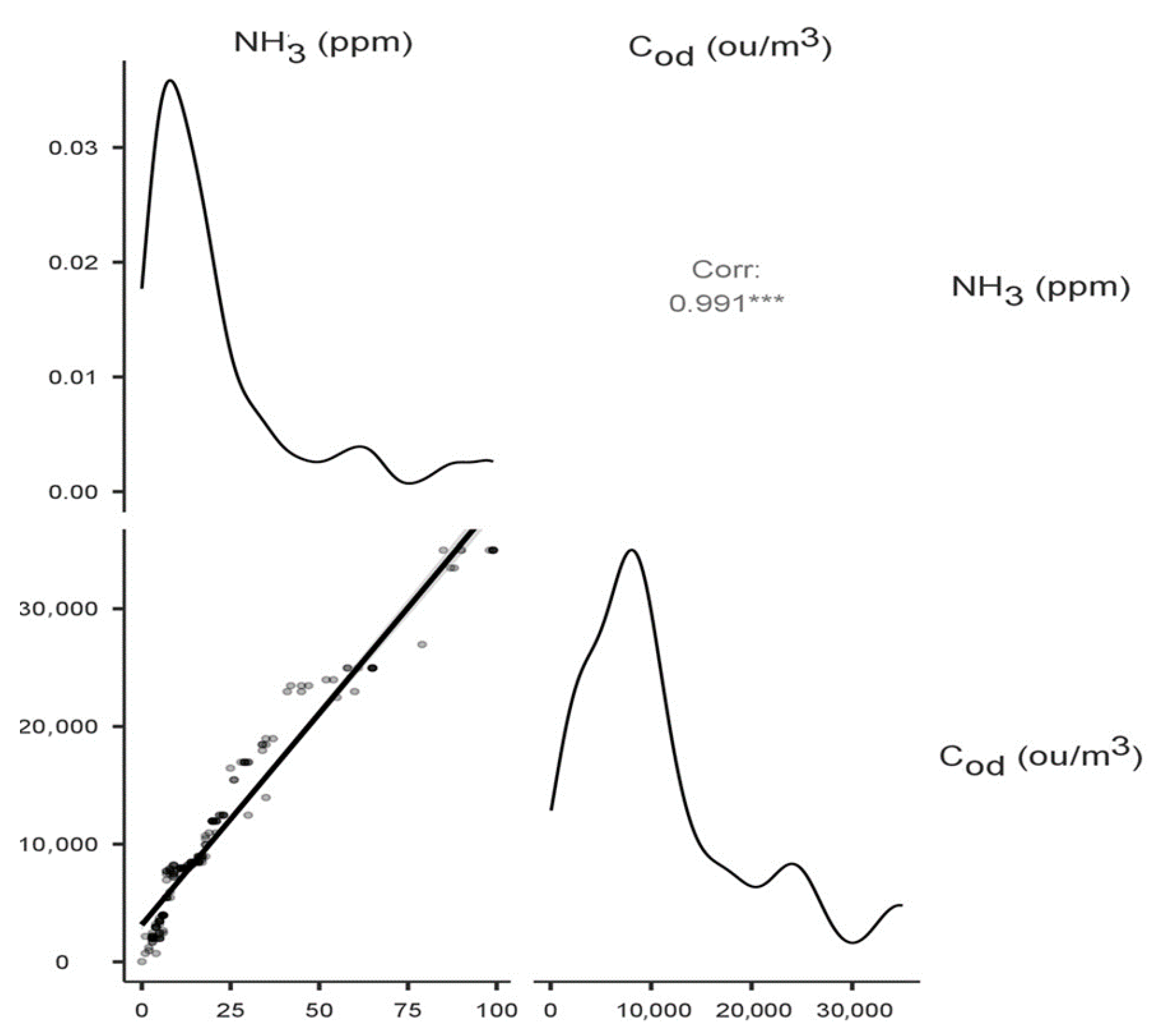
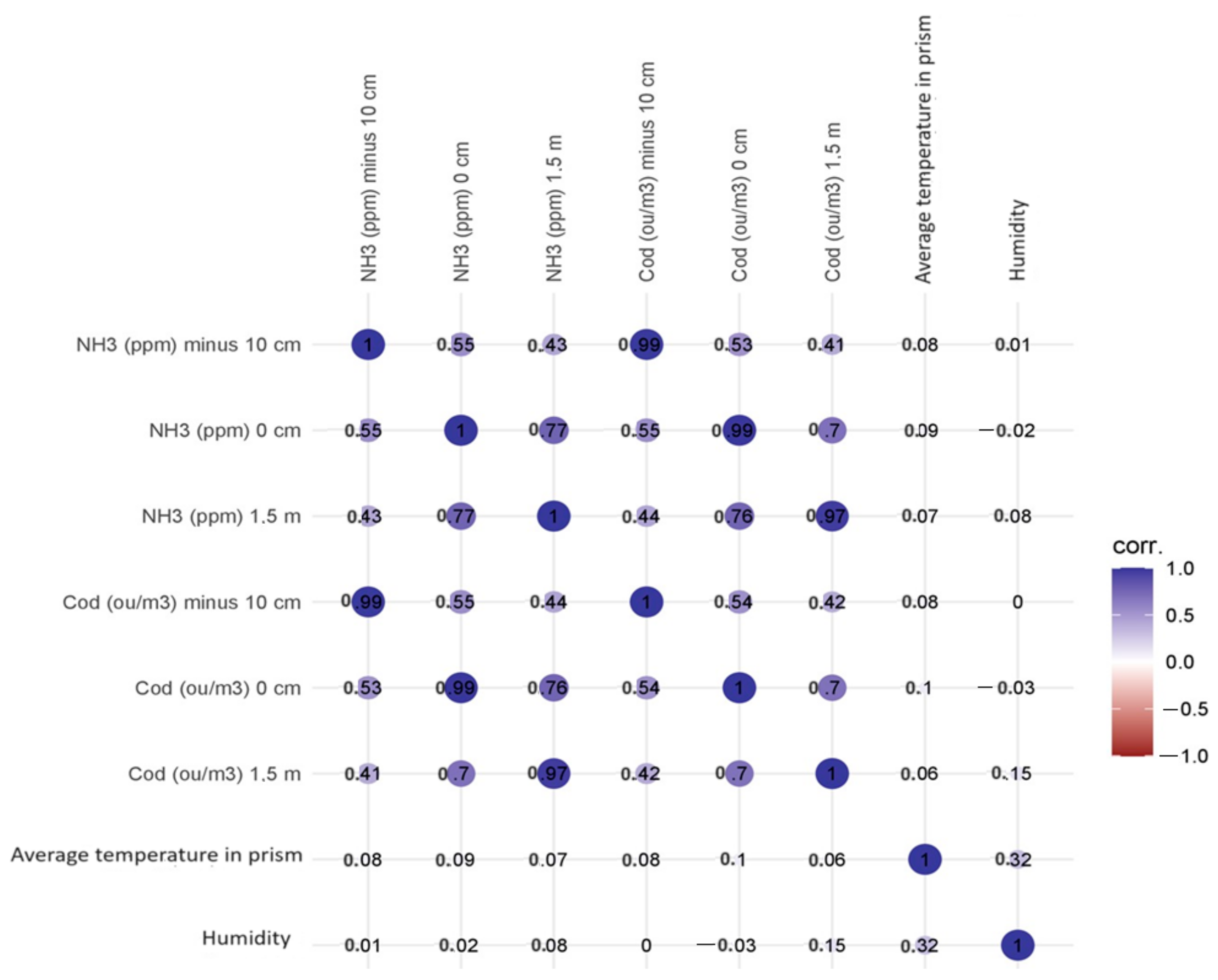
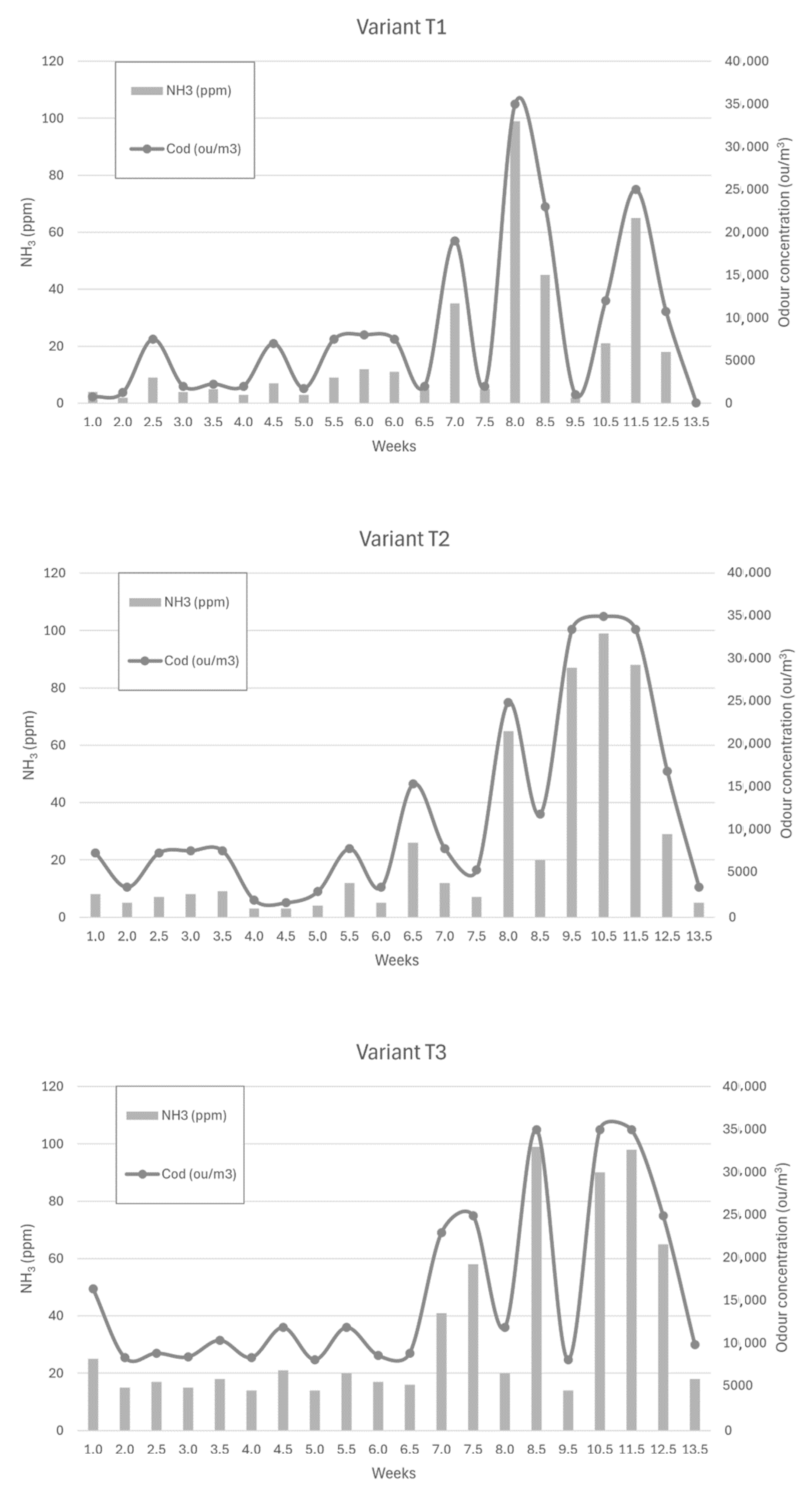

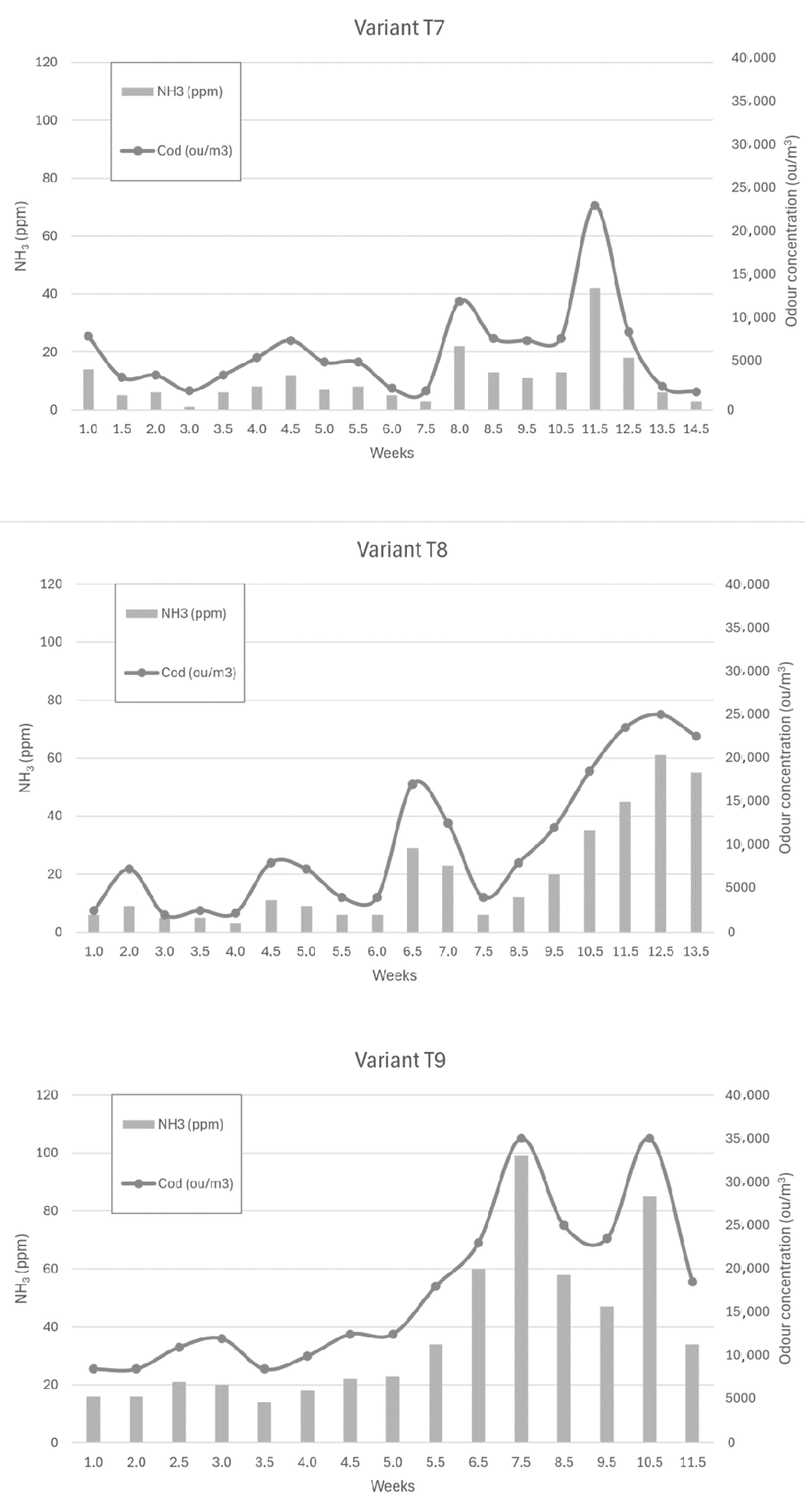
| Share of the Intermediate Fraction | Addition of the Preparation | Without Addition | |
|---|---|---|---|
| A (Liquid) | B (Powder) | ||
| Variant | |||
| 80% of wastes (~452 m3) and 20% of intermediate fraction (~113 m3) | T1 | T2 | T3 |
| 91% of wastes (~514 m3) and 9% of intermediate fraction (~51 m3) | T4 | T5 | T6 |
| No intermediate fraction | T7 | T8 | T9 |
Disclaimer/Publisher’s Note: The statements, opinions and data contained in all publications are solely those of the individual author(s) and contributor(s) and not of MDPI and/or the editor(s). MDPI and/or the editor(s) disclaim responsibility for any injury to people or property resulting from any ideas, methods, instructions or products referred to in the content. |
© 2024 by the authors. Licensee MDPI, Basel, Switzerland. This article is an open access article distributed under the terms and conditions of the Creative Commons Attribution (CC BY) license (https://creativecommons.org/licenses/by/4.0/).
Share and Cite
Szyłak-Szydłowski, M.; Kos, W. Application of Sensory Methods to Evaluate the Effectiveness of Solutions to Reduce the Exposure to Odour Nuisance and Ammonia Emissions from the Compost Heaps. Sensors 2024, 24, 4200. https://doi.org/10.3390/s24134200
Szyłak-Szydłowski M, Kos W. Application of Sensory Methods to Evaluate the Effectiveness of Solutions to Reduce the Exposure to Odour Nuisance and Ammonia Emissions from the Compost Heaps. Sensors. 2024; 24(13):4200. https://doi.org/10.3390/s24134200
Chicago/Turabian StyleSzyłak-Szydłowski, Mirosław, and Wojciech Kos. 2024. "Application of Sensory Methods to Evaluate the Effectiveness of Solutions to Reduce the Exposure to Odour Nuisance and Ammonia Emissions from the Compost Heaps" Sensors 24, no. 13: 4200. https://doi.org/10.3390/s24134200
APA StyleSzyłak-Szydłowski, M., & Kos, W. (2024). Application of Sensory Methods to Evaluate the Effectiveness of Solutions to Reduce the Exposure to Odour Nuisance and Ammonia Emissions from the Compost Heaps. Sensors, 24(13), 4200. https://doi.org/10.3390/s24134200








